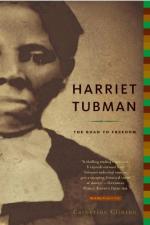|
This section contains 553 words (approx. 2 pages at 400 words per page) |

|
Harriet Tubman: The Road to Freedom Summary & Study Guide Description
Harriet Tubman: The Road to Freedom Summary & Study Guide includes comprehensive information and analysis to help you understand the book. This study guide contains the following sections:
This detailed literature summary also contains Essay Topics on Harriet Tubman: The Road to Freedom by Catherine Clinton.
Harriet Tubman: The Road to Freedom examines the life and significance of Harriet Tubman. Tubman was born a slave in the 1820s in Maryland. She escaped slavery in her early 20s and made her way north. Within a year of her escape, she began helping others reach freedom, putting her own life in danger to do so. During the Civil War, she helped establish a spy ring in South Carolina and worked to ease the transition to freedom for thousands of former slaves. After the war, she settled in Auburn, New York and continued to help those who needed it. She established a charity home for needy and neglected African Americans.
Tubman was born Araminta Ross sometime in the early 1820s. Both of her parents were also slaves. She was hired out at very young ages to neighbors of her master and was often treated harshly at these places. As an adolescent, she was hit in the head with a lead weight, when she stepped between an angry master and another slave. Although she recovered, she suffered from visions and debilitating periods throughout her life, which may have been due to this. She married a free black named John Tubman in 1844.
In 1849, Tubman escaped to freedom in the north. Little is known about how she escaped, but once she reached Philadelphia, she took the name Harriet Tubman. In 1850, the Fugitive Slave Law gave sweeping authority to local federal commissions in fugitive slave cases. Slave catchers and others were paid regardless of whether the African American they picked up was a fugitive or not.
Within a year of her escape, Tubman secretly returned to the South to help several family members escape before they were sold farther south. She more than likely used the networks of the Underground Railroad (UGRR). This began her vocation of helping slaves escape to Canada. In the winters, she stayed in Canada with family members, going into New England in the spring and summer to earn money for another clandestine journey into the South in the fall to bring out more slaves. She became known as the Moses of her people. She used various UGRR stations and stationmasters to help her.
When the Civil War began in 1861, Tubman went to Fort Monroe in Virginia. The fort had become a magnet for fleeing slaves and Tubman worked as a nurse, cook, and laundress. In 1962, the Massachusetts governor asked Tubman to travel with others from the state to Port Royal, South Carolina. She worked with the head doctor at the freedman's hospital and she also used her knowledge of local plants and remedies to help both soldiers and former slaves. In 1863, Tubman was asked to organize scouts to infiltrate and map the interior. Her spy ring was responsible for the famed Combahee River Raid in June 1863.
After the war, Tubman returned to Auburn, New York, where she had a house and where her parents now lived. She began to help the poor and neglected African Americans in the area. She also became involved in women's suffrage. She married Nelson Davies in 1869. Their household remained full of family and others who needed support. Tubman worked toward establishing a charitable institution in Auburn for blacks that were poor and neglected. In 1908, the Harriet Tubman Home opened. She died in 1913.
Read more from the Study Guide
|
This section contains 553 words (approx. 2 pages at 400 words per page) |

|



